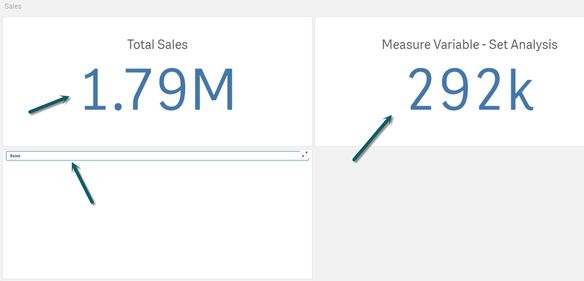Unlock a world of possibilities! Login now and discover the exclusive benefits awaiting you.
- Qlik Community
- :
- Forums
- :
- Analytics
- :
- New to Qlik Analytics
- :
- Re: Set expression with a variable instead of fiel...
- Subscribe to RSS Feed
- Mark Topic as New
- Mark Topic as Read
- Float this Topic for Current User
- Bookmark
- Subscribe
- Mute
- Printer Friendly Page
- Mark as New
- Bookmark
- Subscribe
- Mute
- Subscribe to RSS Feed
- Permalink
- Report Inappropriate Content
Set expression with a variable instead of field
Hi
Am new to Qlik Sense, and practicing the tool. I need help and will greatly appreciate your support.
I have a pre-defined variable created in the script, which consolidates the total balances in banks. Am creating a new sheet, and in the table, i want to show the Country & the bank balance. The Variable is $(CashBalancesAmountYTDCurrent)
When i drag the country dimension and this variable, everything works fine, however i would want to limit the output to these conditions (and it should not be affected by other selections). Corporate Currency Code should "JPY" and Month & Year should be "May 2020"
i've tried the below expression, and the output is just '-' (null)
Sum({1<[Corporate Currency Code]={"JPY"},[Month & Year]={"May 2020"}>}$(CashBalancesAmountYTDCurrent))
Appreciate your help
- « Previous Replies
-
- 1
- 2
- Next Replies »
- Mark as New
- Bookmark
- Subscribe
- Mute
- Subscribe to RSS Feed
- Permalink
- Report Inappropriate Content
What is the format of [Month & Year]?
What you have defined with the variable CashBalancesAmountYTDCurrent?
- Mark as New
- Bookmark
- Subscribe
- Mute
- Subscribe to RSS Feed
- Permalink
- Report Inappropriate Content
Month & Year is Date format. The variable is a lengthy If statement defined by the service provider
- Mark as New
- Bookmark
- Subscribe
- Mute
- Subscribe to RSS Feed
- Permalink
- Report Inappropriate Content
Hi Saialkesh - I replied to your DM as well - please see attached example .qvf file - upload to your current environment.
it may be how your set expression is written, for example this works for me - changing the measure dynamically - with the Set Expression
SUM({$<CategoryName={'Sportwear'}>}[$(vMeasure)])
I defined vMeasure in my variables as Sales
The used a variable input box to assign the Variable - either Sales or COS
Let me know how you make out
Regards,
Mike
Mike Tarallo
Qlik
- Mark as New
- Bookmark
- Subscribe
- Mute
- Subscribe to RSS Feed
- Permalink
- Report Inappropriate Content
Hello @Michael_Tarallo
Thank you so much for responding.
I tried the suggested formula, however i get null values. The variable that am using (CashBalancesAmountYTDCurrent) is a lengthy formula, that also includes set expressions within that.
However, when i use the below formula, i do get to see the value of the total variable in the text field, but it displays '0' in the table-
Sum({1<[Account Type]={'Bank Account'},[Cash Flow Status Code]={'AC'},[Year]={2020},[Month]={'May'},[Bank Description 1]-={'Forecast'}>}$(=$(CashBalancesAmountYTDCurrent)))
Kind Regards
Sai.
- Mark as New
- Bookmark
- Subscribe
- Mute
- Subscribe to RSS Feed
- Permalink
- Report Inappropriate Content
First things first; how is this defined? $(CashBalancesAmountYTDCurrent)
- Mark as New
- Bookmark
- Subscribe
- Mute
- Subscribe to RSS Feed
- Permalink
- Report Inappropriate Content
I guess the point to understand here is that you cannot use Sum on top of another sum without using Aggr() function. So for instance
Sum(If(X=0, Sum(Y))) isn't valid...
this is because your inner sum doesn't know what dimensions do you need to evaluate the inner sum on. So you need to provide dimensions for the inner sum using Aggr() function like this
Sum(Aggr(If(X=0, Sum(Y)), Dim1, Dim2, Dim3))
Now coming back to your expression... you can definitely add additional constraints via your outer Sum with Aggr() like this
Sum({1<[Account Type]={'Bank Account'},[Cash Flow Status Code]={'AC'},[Year]={2020},[Month]={'May'},[Bank Description 1]-={'Forecast'}>}Aggr($(=$(CashBalancesAmountYTDCurrent)), Dimension/s))
but to make sure that you are able to ignore selections, you will have to add {1} to your inner expression as well. This is because if inner expressions get filtered out, the outer Sum will not be able to bring them back. In order to ignore selection, both inner and outer will have to ignore dimensions. Filter can be done within inner, outer or both set analysis.
- Mark as New
- Bookmark
- Subscribe
- Mute
- Subscribe to RSS Feed
- Permalink
- Report Inappropriate Content
Dear @sunny_talwar
Thank you so much for your advise.
I tried correcting the formula, but still get the same results (0.00). This is the revised formula:
Sum({1<[Account Type]={'Bank Account'},[Cash Flow Status Code]={'AC'},[Year]={2020},[Month]={'May'},[Bank Description 1]-={'Forecast'}>}Aggr{1<($(=$(CashBalancesAmountYTDCurrent))>},)
The variable that is used here is: CashBalancesAmountYTDCurrent, and this has a lengthy formula, including set analysis in there. The intent is to create a static filter with the above parameters, so that user does not have to change it. The only way, am able to do it now, is through Story.
Appreciate your help
Kind regards
sai.
- Mark as New
- Bookmark
- Subscribe
- Mute
- Subscribe to RSS Feed
- Permalink
- Report Inappropriate Content
I don't see the usage of dimension in your new expression... you added Aggr(), but not it's dimension....
- Mark as New
- Bookmark
- Subscribe
- Mute
- Subscribe to RSS Feed
- Permalink
- Report Inappropriate Content
Dear @sunny_talwar
Sorry, but can you please guide me on whats missing here. Am not familiar with this. All the values, that i need, i can get from the variable (CashBalancesAmountYTDCurrent). What dimension should i be adding to the syntax
Appreciate your guidance.
- « Previous Replies
-
- 1
- 2
- Next Replies »

